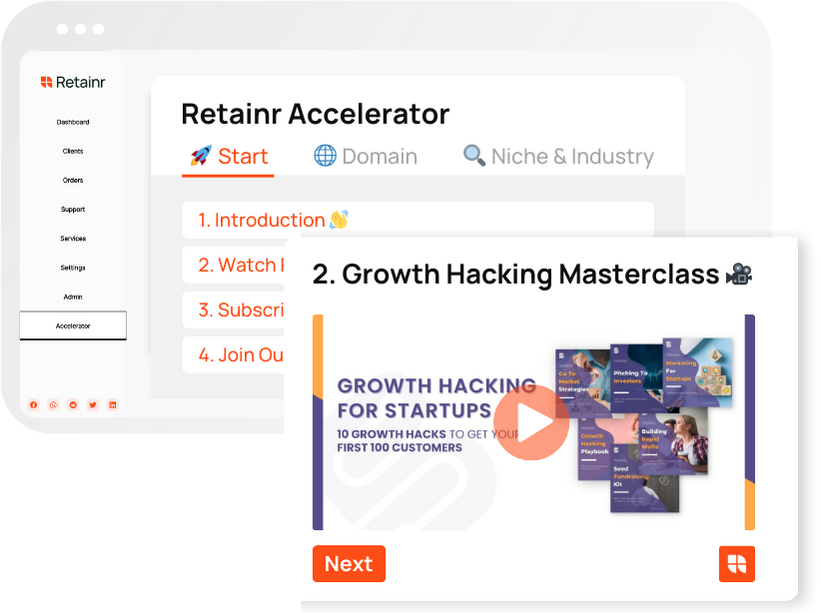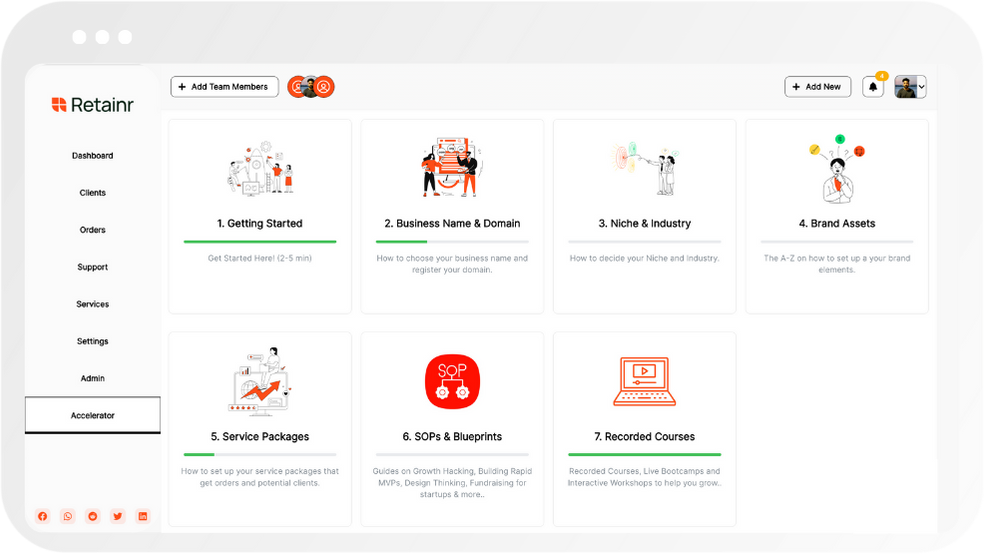
7 Best Processes to Automate at Work
Build with Retainr
Sell your products and services, manage clients, orders, payments, automate your client onboarding and management with your own branded web application.
Get Started1. What are the seven best processes to automate at work?
The Seven Best Processes to Automate at Work
Automation can bring significant improvements in efficiency, accuracy and productivity in the workplace. It can reduce manual and repetitive tasks, freeing up time for more meaningful work. Here are seven processes that, when automated, can greatly benefit any business:
- Invoicing and Billing - Automating this process can eliminate errors and delays in payment cycles.
- Payroll Processing - Tends to be quite time-consuming and prone to errors if done manually.
- Customer Support - Automation tools such as chatbots can provide instant support to customers.
- Email Marketing - Email marketing tools can automate the process of sending tailored emails to customers.
- Social Media Posting - Posting on social media platforms can be automated using various tools.
- Data Backup and Syncing - During non-working hours, backup and syncing of important data can be automated.
- Employee Onboarding - This process involves numerous steps that can be automated to save time.
The Benefits of Automating These Processes
Automation can reduce employee work hours, lower operating costs, and minimize errors in the workplace. Below is a table showcasing the benefits of automating these listed processes:
| Process | Benefits |
|---|---|
| Invoicing and Billing | Saves time, increases accuracy, and improves cash flow |
| Payroll Processing | Ensures timely payments and reduces manual errors and fraud |
| Customer Support | Provides instant, 24/7 support and improves customer satisfaction |
| Email Marketing | Improves engagement, conversion rates and customer retention |
| Social Media Posting | Ensures consistent presence on social media and drives brand awareness |
| Data Backup and Syncing | Guarantees data safety, availability, and eliminates the risk of data loss |
| Employee Onboarding | Reduces HR workload and provides a seamless experience for new hires |
2. How can automation improve these seven work processes?
Improvement of Work Processes Through Automation
Automation leverages technology to improve various work procedures, resulting in increased efficiency and productivity. The seven work processes that can be drastically improved through automation include: project management, customer support, human resources, data entry, scheduling, communication, and reporting.
- Project Management: Automation tools keep track of project timelines, allocate tasks, and monitor progress, thereby keeping the whole team updated and aligned.
- Customer Support: Support tickets can be automatically sorted and prioritized, chatbots can answer common queries, and follow-ups can be scheduled, improving customer satisfaction.
- Human Resources: Automation can handle tasks like onboarding, contract renewals, and performance reviews, freeing HR personnel to focus on more critical aspects like employee engagement.
- Data Entry: Automated data entry not only saves time but also minimizes the risk of human error, ensuring the accuracy of data.
- Scheduling: Tools like calendar software can automate scheduling, reducing conflicts and improving time management.
- Communication: Automatic reminders, notifications, and updates can streamline communication within a team, making collaboration smoother.
- Reporting: Automated reporting can provide timely and accurate data, aiding in timely decision-making and strategy planning.
Summary Table of Improvements
| Work Process | Benefits of Automation |
|---|---|
| Project Management | Timely task allocation, progress monitoring |
| Customer Support | Improved ticket sorting, customer satisfaction |
| Human Resources | Efficient onboarding, performance reviews |
| Data Entry | Accurate data, time-saving |
| Scheduling | Improved time management |
| Communication | Smoother collaboration, reduced missed communications |
| Reporting | Timely, accurate data for decision making |
3. What are the benefits of automating these specific processes at work?
Benefits of Automating Work Processes
Automating work processes brings a variety of benefits to both the organization and employees. The key advantages can be grouped under three main categories: Efficiency Increase, Quality Improvement, and Employee Satisfaction Boost.
Efficiency Increase
- Time-saving: Automated processes take less time to execute as compared to manual processes. This ensures tasks get completed faster, thus saving valuable time.
- Improved productivity: Automation frees up employees from time-consuming routine tasks, enabling them to focus on high-value work.
- Cost saving: Automation, by reducing labor intensity, can lead to significant cost savings in the long run.
Quality Improvement
| Aspect | Benefit |
|---|---|
| Consistency | Automation ensures every process is executed in exactly the same way, bringing consistency on the output. |
| Error Reduction | Automated processes are less prone to errors as compared to manual processes, helping in maintaining high-quality standards. |
| Compliance | With automation, it's easier to comply with industry standards and norms, as the processes are consistent and controllable. |
Employee Satisfaction Boost
Automation, by eliminating repetitive and mundane tasks, allows employees to focus on strategic tasks, hence increasing job satisfaction. It also reduces workplace stress as employees are assured that routine jobs will be taken care of automatically. Hence, automation fosters a healthier workplace environment leading to boosted employee morale and productivity.
4. Are there any potential drawbacks to automating these processes?
Potential Drawbacks of Automating Work Processes
While automation has proven to be a worthwhile endeavor in most business operations, it is still not devoid of potential drawbacks. Depending on several factors such as the business model, size, industry, and resources available, varying challenges and risks may surface
The first potential drawback is the initial cost needed to establish automated processes, especially for small and midsize businesses. While automation may bring significant savings in the long run, the early stages often necessitate substantial investments in software, hardware, and training. Such investments may not be feasible for some businesses, especially those operating with tight cash flows.
- Initial Costs: Investment in software, hardware, and training
Another concern associated with automation is the risk associated with potential job losses. While it's true that automation can significantly increase efficiency, it often comes at the expense of manual jobs. Consequently, employees may feel threatened by automation, which may lead to resistance and decrease in morale.
- Potential Job Losses: Employees may feel their positions being threatened
Also, reliance on automated systems could lead to vulnerability in the face of technical glitches, outages, or cyber-attacks. It's critical to have contingency plans in place should such situations arise to ensure continuity of business operations.
- Technical Vulnerabilities: Risk of technical glitches, outages, or cyber-attacks
| Drawbacks | Description |
|---|---|
| Initial Costs | Investment in software, hardware, and training |
| Potential Job Losses | Employees may feel their positions being threatened |
| Technical Vulnerabilities | Risk of technical glitches, outages, or cyber-attacks |
It's important to balance the advantages and potential drawbacks of automating work processes and plan for a smooth transition to avoid these potential pitfalls.
5. Can these process automations be used in any type of business or industry?
General Applicability of Process Automation
It is a common question whether process automation is suitable for all types of businesses or industries. The answer is overwhelmingly positive as process automation endows businesses across diverse sectors with increased efficiency. While the specific processes to be automated may vary depending on the nature of the business, the principle remains the same across the board.
Examples Across Different Industries
The following are a few examples of businesses and industries that stand to reap substantial benefits from the application of process automation.
| Industry | Processes to Automate |
|---|---|
| Manufacturing | Inventory Management, Quality Control, Procurement |
| Healthcare | Patient Data Management, Appointment Scheduling, Billing |
| Retail | Order Processing, Customer Relationship Management, Stock Control |
| Information Technology | Service Desk operations, Incident Management, Network Monitoring |
Factors Influencing Automation Selection
Yet, it's worth noting that while process automation is widely applicable, businesses should consider a few critical factors when it comes to selecting which ones to automate. Firstly, processes that are repetitive, time-consuming, and prone to human error represent ideal candidates for automation. Secondly, businesses should consider the broader organizational impact and the potential for cost savings. Finally, business owners should also consider the potential risks associated with automation, such as security and privacy concerns, before implementing such initiatives.
6. How can one start with the automation of these seven best processes at work?
Getting Started with Automation
Implementing automation in the workplace doesn't happen overnight. Instead, it is a gradual process that requires careful planning and execution. At first, it is essential to identify which tasks are repetitive, time-consuming, and prone to human error. Recommended areas to start include email responses, data entry, scheduling, accounting tasks, time-tracking, new employee onboarding and customer support.
Investing in Automation Tools
- 1. For customer support, tools like Zendesk or Chatbot can help.
- 2. For email responses, email automation software such as Mailchimp is useful.
- 3. Tools like QuickBooks or Sage Intacct can help automate accounting tasks.
- 4. For scheduling, Calendly or Doodle can be of great assistance.
- 5. For time-tracking, consider Toggl or Clockify.
These are just a few of the available tools. Many others can fit better depending on the particular needs of an organization. It's crucial to take time to research and choose the right software.
Create a Table of Implementation Steps
| Steps | Description |
|---|---|
| Identifying tasks | Determine which tasks can be streamlined and automated to increase efficiency and reduce errors. |
| Choosing the right tool | Research and select the appropriate software or tool that fits your needs. |
| Developing an automation strategy | Designing a plan outlining which processes you aim to automate and the estimated timing for each. |
| Implementing automation | Trial the automation tool and train staff on its usage. Make necessary adjustments based on feedback. |
| Evaluating and refining | Regularly review the new process and make any necessary improvements or adaptations. |
This table gives a simplified approach. However, the implementation process can be more complex and requires intentional planning, coordination, and continuous evaluation.
7. What tools or software are recommended for automating these processes?
Task Automation Tools
There are numerous software tools that can be leveraged to automate various work processes, ultimately transforming the workflow and improving productivity. A list of seven remarkable ones include:
- Zapier: Zapier stands out as an excellent tool for automating tasks across multiple apps. For example, you can automate the process of saving Gmail attachments to Google Drive.
- IFTTT: Short for 'If This Then That', it helps build automated workflows between apps and services. IFTTT shines in its simplicity and flexibility.
- Microsoft Power Automate: Previously known as Flow, this tool enables the creation of automated workflows between applications and services.
- HubSpot: Besides being a robust CRM solution, HubSpot also offers marketing automation features, making it ideal for marketing teams.
- UiPath: UiPath is a perfect tool for businesses looking for RPA (Robotic Process Automation) solutions. It can automate repetitive tasks like data extraction from documents.
- Automate.io: For seamless, cross-functional automation across cloud applications and services, Automate.io is a potent tool.
- Slack: While primarily known as a communication tool, Slack also offers automation capabilities. For instance, it can integrate with other software and automate the process of sharing updates.
Choosing the Right Productivity Tool
Picking the right tool for process automation mostly depends on the specific business needs, the tools already in use within the organisation, and the workforce's adaptability with new technology. To provide a clearer perspective, a comparison table is outlined below:
| Tool | Key Strength | Best For |
|---|---|---|
| Zapier | Inter-app automation | Small businesses |
| Microsoft Power Automate | Integration with Microsoft Suite | Corporations using Office 365 |
| UiPath | Robotic Process Automation | Large enterprises |
| HubSpot | Marketing automation | Marketing teams |
8. What is the likely cost of automating these seven processes at work?
General Cost Estimation for Automating Work Processes
The financial aspect of automating the seven recommended business processes varies significantly dependant on the intricacies of an organization's procedures, labour costs, and the specific automation tools implemented. While one can not name a precise figure without a thorough analysis of your business, we will provide an average range of costs that may be encountered.
Cost Breakdown
- Software Costs: Depending on whether an organization opts for a physical installation or a cloud-based software-as-a-Service (SaaS), costs can range from $10 to $100 per user per month. For more comprehensive AI-driven solutions, it could reach up to $200,000.
- Hardware Costs: Hardware costs can be an upfront one-time investment or a recurring charge based on service providers. The charges can vary significantly starting from $2,000 to $20,000 and upwards.
- Implementation Costs: This involves the charges for integrating the automation process within the existing system. Ligistics can range from $5000 to $50000.
- Training Costs: Ensuring that the team is adept at using the automation tools comes with its own expenses, with prices varying based on who provides the training.
- Maintenance and Upgrades: Automation is a long-term investment, meaning maintenance and upgrades are necessary. The cost varies depending on the complexity of the automated processes and the software providers.
Approximate Costs Table
| Cost Category | Approximate Cost Range |
|---|---|
| Software Costs | $10 - $200,000/user/month |
| Hardware Costs | $2,000 - $20,000 |
| Implementation Costs | $5,000 - $50,000 |
| Training Costs | Variable |
| Maintenance and Upgrades | Variable |
9. How much time can be saved by automating these seven best processes?
Time Saved by Automating Work Processes
The impact of automation on work process efficiency is quite significant. In fact, according to a McKinsey Global Institute report, about 60% of all jobs could have at least 30% of their activities automated. This translates into substantial time savings for organizations. Let's break down how much time could potentially be saved by automitating these seven best processes:
- Email Automation
- Task Schedules or Job Queues
- Invoice Processing Automation
- IT & Help Desk Automation
- Data Backups
- Onboarding Process
- Customer Support
Indeed, the exact amount of time saved will vary depending on the complexity of the tasks, volume of work, and the efficiency of the Automation software. However, in general, automation can drastically reduce the time spent on repetitive and manual tasks, thereby freeing up employees to focus on tasks that require human intelligence and creativity.
Estimating Time Savings
In terms of quantifying time savings, consider the following estimates. Note that these are based on averages and actual savings can vary. Furthermore, it's important to factor in the initial time investment required to set up the automated system.
| Process | Estimated Time Saved per Week (in hours) |
|---|---|
| Email Automation | 5 |
| Task Schedules | 10 |
| Invoice Processing | 12 |
| IT & Help Desk | 14 |
| Data Backups | 8 |
| Onboarding Process | 15 |
| Customer Support | 20 |
10. Can these automated processes easily be adjusted or updated if necessary?
Adjustibility and Updates: Automated Work Processes
The majority of automated systems include features that make it easy to adjust or update procedures as needed. Processes that are rigid and difficult to modify limit the benefits of automation as changes in business operations and workflows are inevitable. Therefore, flexibility is key when considering which processes to automate.
- Automated Emails: Many email marketing platforms make it simple to change templates, adjust messaging, or modify targeted recipients.
- Online Scheduling Systems: Booking software often allows for easy adjustments in available times, services being offered, or price points.
- Customer Relationship Management (CRM): Most CRM tools offer the ability to personalise workflow stages, ensuring it aligns with the company's sales process.
- Data Analysis and Reporting: Data analysis software often provides easy means to change variables or parameters in order to gain different viewpoints on the data.
- Social Media Posting: Social media automation tools often include functionality to change posting schedules or content.
| Automated Process | Ability to Adjust or Update |
|---|---|
| Automated Emails | High |
| Online Scheduling Systems | High |
| Customer Relationship Management (CRM) | High |
| Data Analysis and Reporting | Moderate |
| Social Media Posting | Moderate |
In spite of the high adjustability, companies should always shop around and test several tools before settling for what to use. Automation software that cannot be adjusted to fit the company’s unique requirements can potentially stagnate growth by limiting adaptability in the face of changes.
Conclusion
Summary of the 7 Best Processes to Automate at Work
Automation in the workplace can significantly increase performance and efficiency while reducing human error. From streamlining repetitive tasks to managing workflows, automation offers several benefits. Here are the seven best processes to automate at work:
- Email Communication: Automating email responses and follow-ups can save time and ensure quick replies.
- Project Management: With automated project management, tasks can be tracked and progress monitored in real time.
- Employee Onboarding: Automation can streamline the onboarding process, making it quicker and more efficient.
- Customer Relationship Management (CRM): Automation makes it easier to manage customer service tasks and follow-up communication.
- Invoice and Expense Management: Automation reduces the risk of errors in financial processes.
- Social Media Posting: Scheduling posts and automating responses can help maintain a consistent online presence.
- Reporting and Analytics: Automated systems can collect and analyze data for more accurate reporting.
While automation is game-changing, it's crucial to have the right software. Here, Retainr.io comes into play. Retainr.io is a whitelabel software that provides you with your own branded App to sell, manage clients, orders, and payments. It takes care of your tasks, so you can focus more on growing your business. Automate your work processes with Retainr.io and experience an elevated level of efficiency and productivity.
Boost Your Agency Growth
with Retainr Accelerator
Uncover secrets, strategies, and exclusive blueprints to take your agency's growth to the next level — from marketing insights to effective presentations and leveraging technology.

SOPs, Cheatsheets & Blueprints
Leverage 50+ SOPs (valued over $10K) offering practical guides, scripts, tools, hacks, templates, and cheat sheets to fast-track your startup's growth.
Connect with fellow entrepreneurs, share experiences, and get expert insights within our exclusive Facebook community.
.jpg)

Join a thriving community of growth hackers. Network, collaborate, and learn from like-minded entrepreneurs on a lifelong journey to success.

Gain expertise with recorded Courses, Live Bootcamps and interactive Workshops on topics like growth hacking, copywriting, no-code funnel building, performance marketing and more, taught by seasoned coaches & industry experts.

.jpg)

.jpeg)


